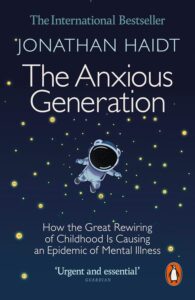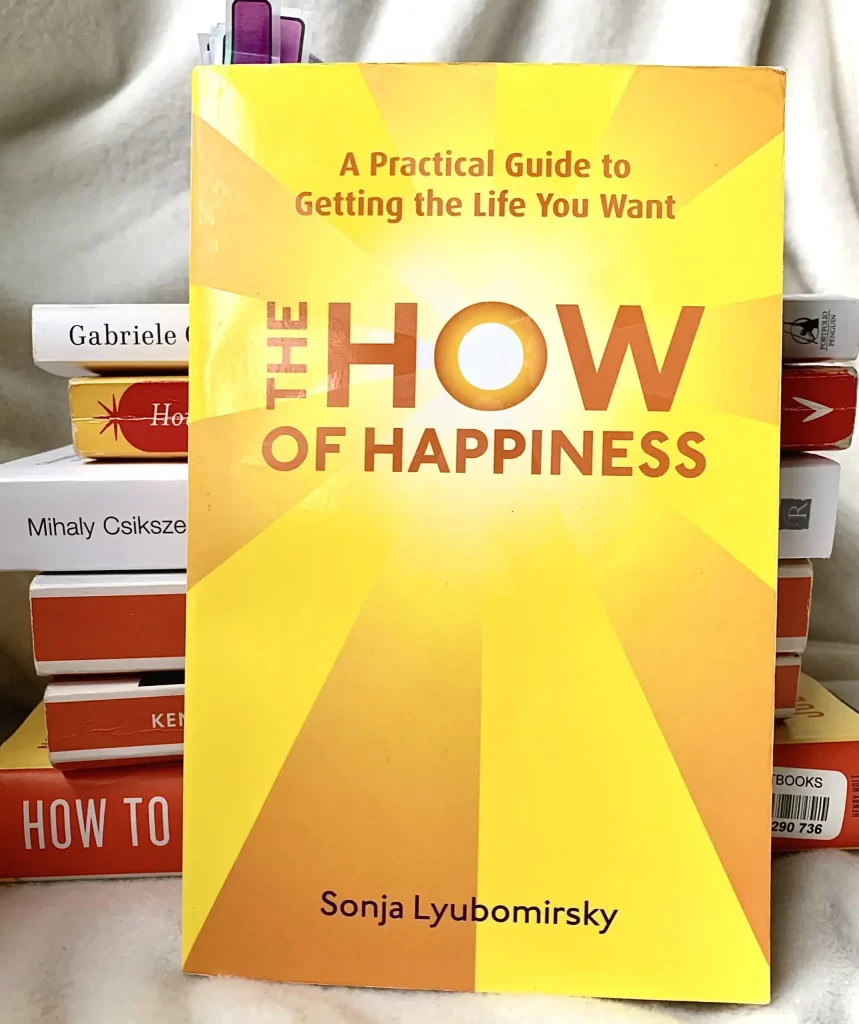 The Anxious Generation
The Anxious Generation
How the Great Rewiring of Childhood Is Causing an Epidemic of Mental Illness
Jonathan Haidt
Penguin (26 Mar. 2024)
About Jonathan Haidt
Jonathan Haidt is the Thomas Cooley Professor of Ethical Leadership at New York University’s Stern School of Business. He obtained his PhD in social psychology from the University of Pennsylvania in 1992 and taught at the University of Virginia for sixteen years. His research focuses on moral and political psychology, as described in his book The Righteous Mind. His latest book, The Anxious Generation, is a direct continuation of the themes explored in The Coddling of the American Mind (written with Greg Lukianoff). He writes the After Babel Substack.
About The Anxious Generation:
“Gen Z became the first generation in history to go through puberty with a portal in their pockets that called them away from the people nearby and into an alternative universe that was exciting, addictive, unstable, and—as I will show—unsuitable for children and adolescents. Succeeding socially in that universe required them to devote a large part of their consciousness—perpetually—to managing what became their online brand. This was now necessary to gain acceptance from peers, which is the oxygen of adolescence, and to avoid online shaming, which is the nightmare of adolescence. Gen Z teens got sucked into spending many hours of each day scrolling through the shiny happy posts of friends, acquaintances, and distant influencers. They watched increasing quantities of user-generated videos and streamed entertainment, offered to them by autoplay and algorithms that were designed to keep them online as long as possible. They spent far less time playing with, talking to, touching, or even making eye contact with their friends and families, thereby reducing their participation in embodied social behaviors that are essential for successful human development.
The members of Gen Z are, therefore, the test subjects for a radical new way of growing up, far from the real-world interactions of small communities in which humans evolved. Call it the Great Rewiring of Childhood. […]
There’s a second plotline here: the well-intentioned and disastrous shift toward overprotecting children and restricting their autonomy in the real world. […]
My central claim in this book is that these two trends—overprotection in the real world and underprotection in the virtual world—are the major reasons why children born after 1995 became the anxious generation.”
Over the past few months, I’ve spoken to quite a few parents – highly educated ones, including a nursery headteacher – who’ve admitted something they deeply regret: giving their child a smartphone too early. They’ve seen dramatic changes in their kids and wish they could turn back time. I’ve also met teenagers who’ve been glued to their phones for years and are now struggling with anxiety, depression, and significant learning challenges at school.
With my eldest turning 10 this year, I couldn’t help but ask the question: What’s really going on? How is modern technology shaping our children – and us? And more importantly, what can we do about it?
This book had been popping up in my “Recommended for You” section on Amazon for months. I finally picked it up after a fellow parent from my son’s class mentioned it – and I’m so glad I did. I finished reading it just before the buzz around the Adolescence Netflix series started, and it made me realize how timely and urgent Jonathan Haidt’s message really is. He’s done an incredible job bringing this crucial topic into the spotlight.
I’ve been curious about the effects of technology on our lives for a while now. One of the most eye-opening books I read years ago was Irresistible by Adam Alter, which dives into how tech hijacks our brains and behaviours. Then came Bored and Brilliant by Manoush Zomorodi and Deep Work by Cal Newport – books aimed at helping us, adults, reclaim our time and focus in a distracted world.
But Jonathan Haidt does something different. He zooms in on our kids—and the results are unsettling. He unpacks how childhood has radically changed over the past two decades, and the consequences we’re only beginning to understand.
I genuinely believe this is one of the most important parenting books of our time.
Let’s have a quick look at my favourite ideas from the book.
P.S. I watched the Netflix series Adolescence after finishing the book, and it hit me hard—especially the scene where Jamie’s dad says he thought his son was safe upstairs in his room. That line has stayed with me.
Key Insights:
What Kids Need?
“…evolution didn’t just lengthen childhood to make learning possible. It also installed three strong motivations to do things that make learning easy and likely: motivations for free play, attunement, and social learning.”
In one of the most powerful chapters of the book, Jonathan Haidt takes us back to basics – what kids actually need to grow into healthy, resilient, and well-adjusted humans. And spoiler alert: it’s not curated content or endless screen time.
Haidt explains that evolution didn’t just stretch childhood to allow time for learning – it hardwired kids with three powerful motivations that make learning feel natural and joyful: free play, attunement, and social learning.
Free Play
This is where the real magic of childhood happens. Free, unstructured play isn’t just fun – it’s the primary way children learn essential life skills: negotiating, taking turns, resolving conflict, managing emotions, building resilience. When we remove opportunities for free play (by over-scheduling or replacing it with screens), we cut off a vital developmental tool.
Attunement
Children are wired to be with others – especially peers. Through shared experiences, play, and emotional connection, they generate what Haidt calls “social electricity.” It’s this sense of being seen, understood, and part of something that nourishes their mental and emotional development. Screens can simulate connection, but they don’t create the same charge.
Social Learning
Kids learn by watching, imitating, and modelling behaviour – especially from adults. But when real-life role models are absent or emotionally unavailable, kids turn to the next best thing: influencers. Often, these online personalities come with controversial values and lifestyles, which kids absorb through constant exposure. Social media, Haidt warns, is “the most efficient conformity engine ever invented” – and not necessarily one that shapes kids for the better.
This chapter makes it clear: when we crowd out play, limit real-world connection, and hand over social learning to algorithms, we’re interfering with ancient, beautifully designed systems of growth. And the consequences might be devastating.
P.S. If you’re interested in diving deeper into the science of play, I highly recommend checking out our notes on Play by Stuart Brown and Free to Learn by Peter Gray. These two books have deeply influenced how I raise my boys – and I revisit them often.
P.P.S.: Also, we have a series of articles exploring play – check them out: 11 Ideas On How To Bring More Free Play Into Your Child’s Life , 4 Reasons Why Our Children Play Less Now (And The Scary Consequences You Didn’t Think About) and The Power of Play – Why Playtime Matters?
Discovery Mode and the Need for The Risky Play
One of the most striking insights in the book is Jonathan Haidt’s explanation of discovery mode – a natural, vital state of the human brain that’s essential for learning, confidence, and emotional resilience.
Haidt explains that the human brain operates in two primary modes:
- Discovery mode – when we’re curious, open, and actively seeking out opportunities.
- Defend mode – when we’re on high alert, scanning for threats and trying to stay safe.
Children are biologically wired to spend their early years in discovery mode. Think about it: kids are natural thrill-seekers. They want to explore, climb, take risks, shriek with laughter, and test their limits. This isn’t just wild energy – it’s how their brains get wired for confidence and competence.
Remember Jordan Peterson’s Rule 11 from his book 12 Rules For Life: “Do not bother children when they are skateboarding?” That’s it!
As Haidt puts it:
“Children need to swing and then jump off the swing. They need to explore forests and junkyards in search of novelty and adventure.”
Through these kinds of experiences, kids learn to judge risk, make decisions, handle consequences, and discover that even when things go wrong, they’re usually okay. In short, they build courage, independence, and grit.
But here’s the problem: many kids today – especially those born after 1995 – aren’t getting enough of risky play. Instead, they’re growing up in a digital landscape and the culture of “safetism” that keeps them stuck in defend mode. Social media trains them to constantly monitor for social threats: Am I being left out? Do I look good enough? What if I say the wrong thing? It’s like their nervous systems are on high alert, all the time.
The result? More anxiety. Less resilience. A shrinking appetite for life.
The antidote? Free play – especially risky play.
When kids are allowed to climb trees, ride bikes fast, get lost (a little), scrape a knee, and find their way back, they flip the switch back into discovery mode. They learn that the world isn’t something to hide from – it’s something to explore.
As parents, our instinct is often to protect. But sometimes the best way to prepare our kids for life is to let them take (reasonable) risks, fall down, get back up, and feel their own strength.
P.S.: I’m still working on my very own parental anxiety I must admit!
The Great Rewiring of Childhood: The Four Foundational Harms
In the book, Jonathan Haidt builds a compelling case around what he calls “the great rewiring of childhood” – a dramatic shift in the way kids grow up, shaped by the rapid rise of smartphones, social media, and digital entertainment since the early 2010s.
One of the most powerful concepts he introduces is opportunity cost. In simple terms: every hour a child spends scrolling, watching, or gaming is an hour not spent doing something else – like playing outside, seeing friends, sleeping, or just being bored (which, believe it or not, is great for creativity and emotional development).
He outlines four foundational harms caused by this tech-saturated childhood:
Harm #1: Social Deprivation
Kids today spend about half as much time with friends in person as we did growing up. Instead of shared adventures and spontaneous play, much of their socializing happens online – filtered, fragmented, and often superficial. Real-world connection is being replaced by screen-based interaction, which lacks the depth, warmth, and emotional regulation benefits of face-to-face time.
Harm #2: Sleep Deprivation
Teenagers today are sleeping less – and sleeping worse. Haidt points to a steep decline in both the quantity and quality of adolescent sleep, with smartphones being a major culprit (hello, midnight scrolling and glowing notifications). Poor sleep doesn’t just make kids grumpy – it’s directly linked to mental health struggles, lower academic performance, and even increased risk of accidents.
Harm #3: Attention Fragmentation
Focus is the foundation of learning and long-term success. It’s how we do deep work, stay present, and finish what we start. But smartphones – with their constant buzzes, pings, and dopamine hits – are like kryptonite for attention spans. Children are growing up in an environment that trains their brains for constant distraction, not focus.
Harm #4: Addiction
Let’s face it – today’s tech isn’t just available, it’s engineered to be irresistible. Apps, games, and social platforms are designed using neuroscience to hijack our brain’s reward system. Adults struggle with this (well, I certainty do!). But for children and teens, whose brains are still developing, the impact is even more damaging. I still remember how eye-opening Irresistible by Adam Alter was for me – it made it painfully clear how our devices are designed to make us depend on them.
Meta Intentionally Hooked Teens
One of the most chilling revelations in The Anxious Generation comes from what we learned in 2021, when whistleblower Frances Haugen leaked internal Facebook documents – now known as the Facebook Files.
Among them was a presentation given by Facebook employees titled: “The Power of Identities: Why Teens and Young Adults Choose Instagram.”
Let that sink in for a moment. The stated objective of this presentation?
“To support Facebook Inc.–wide product strategy for engaging younger users.”
Translation: How do we get teenagers hooked?
The presentation goes deep into neuroscience, explaining how the adolescent brain develops and pointing out that the frontal cortex – the part responsible for decision-making and impulse control – doesn’t fully mature until after age 20. In other words, Facebook knew exactly what they were doing.
They understood that teens are the most vulnerable age group when it comes to forming long-term habits – or, to put it more bluntly, addictions. And they used that science not to protect teens, but to exploit them.
Because from a business standpoint? That’s the perfect age to create a lifelong user.
Ethics? Who cares when the revenue graphs are up and to the right.
Disturbing? Yes. Surprising? Sadly, no.
And here’s the kicker: after all that, is age verification properly enforced now? Nope.
Is the content our kids are exposed to on social media well-regulated? Still no.
And it’s not affecting all kids equally either. Girls, in particular, are suffering more harm from social media – higher rates of anxiety, depression, self-harm, and body image issues, all of which Haidt explores in heartbreaking detail.
Spiritual Degradation
One of the most surprising and deeply resonant chapters in the book explores an often-overlooked dimension of modern life: spiritual degradation.
Jonathan Haidt draws on the work of social psychologist David DeSteno, whose book How God Works dives into the science behind spiritual practices – like meditation, prayer, confession, and ritual. DeSteno’s findings are fascinating: while there’s no scientific proof that prayer changes external outcomes (say, curing an illness), there’s strong evidence that spiritual practices improve well-being, emotional resilience, and connection.
Why? Because these practices often do something essential for mental health: they pull us out of ourselves. They reduce self-focus and selfishness. They foster humility and help us feel part of something greater. And when practiced in groups—especially in synchrony, like during communal singing or rituals—they create deep social cohesion, trust, and a sense of belonging.
In today’s hyper-individualistic, tech-saturated world, this sense of connection is exactly what so many of us – especially young people – are missing.
Haidt writes:
“There is a hole, an emptiness in us all, that we strive to fill. If it doesn’t get filled with something noble and elevated, modern society will quickly pump it full of garbage. That has been true since the beginning of the age of mass media, but the garbage pump got 100 times more powerful in the 2010s.”
That really resonated with me. It made me think why “spiritual awakening” content is suddenly everywhere online – even among people who don’t identify with a particular religion. We’re wired to seek meaning, purpose, and something bigger than ourselves. And for centuries, religion and spirituality offered that structure.
Now? Many of those rituals have disappeared from daily life – and in their place, we get infinite scrolls and endless dopamine hits.
It reminded me a lot of Jordan Peterson’s work too, especially his emphasis on meaning, responsibility, and the soul-deep need for structure and belief. Haidt doesn’t argue for religion, but he does advocate for bringing spiritual disciplines – even in secular forms – back into our lives, especially for kids and teens who are trying to figure out who they are in a world that’s constantly distracting them from the answer.
It also resonated a lot with William Damon’s ideas in his amazing book The Path to Purpose.
Collective Action Problems and How to Respond To Them
“Social scientists have long studied traps where each individual does what she thinks is best for herself (such as overfishing in a local pond), even though, when everyone makes the same choice, it leads to a bad outcome for all (the pond stops producing any fish). If the group could coordinate (such as by setting a limit on how many fish each resident can take), the long-term outcome would be far more fish for everyone. These traps are called collective action problems (or sometimes social dilemmas). Preteens are trapped in a collective action problem when they arrive for their first day of sixth grade and see that some of their classmates have gotten smartphones and are connecting on Instagram and Snapchat, even during class time. That puts pressure on them to get a smartphone and social media, even though all students would be better off if none of them had these things.”
This one resonated a lot with me, because it’s my real-time parenting struggle.
My older son just started walking home from school on his own, and almost immediately after the school sent out a letter about the independent walking policy and phone guidelines, he turned to me and asked:
“Can I get a phone? EVERYONE will have one.”
Ugh. That moment. That pressure. It’s the classic collective action problem Jonathan Haidt talks about. And I felt it viscerally.
But then one brave dad in our class WhatsApp group spoke up. He shared his decision not to give his son a phone for the next few years, grounding it in his personal experience with older kids (and I bet he’s read The Anxious Generation). He essentially initiated what Haidt calls “Voluntary Coordination.” He took a stand—and suddenly, the landscape shifted.
I jumped in and said Max wouldn’t be getting a phone either. A few more parents followed. And just like that the “EVERYONE will have one” argument lost its power.
It was one of those quiet but powerful parenting wins that reminded me: we are not powerless. When we join forces, even informally, we can actually change the culture for our kids.
In my younger son’s class, a parent started a WhatsApp group called “Phone-Free Childhood”—a space to raise awareness, share ideas, and remind each other that we’re not alone in this.
By the way, Haidt’s recommendation?
“No smartphones before high school. Parents should delay children’s entry into round-the-clock internet access by giving only basic phones (phones with limited apps and no internet browser) before ninth grade (roughly age 14).”
And I couldn’t agree more with him on this: Schools should be phone-free zones. Kids need space to focus, connect in real life, and be fully present.
P.S. If you haven’t yet, please watch the BBC documentary Swiped. It was clearly inspired by The Anxious Generation, and it captures so beautifully—and painfully—what today’s teens are going through. I watched it with my heart in my throat. Highly, highly recommend.
Action Steps For You
- Delay smartphones: No smartphones before high school. “Parents should delay children’s entry into round-the-clock internet access by giving only basic phones (phones with limited apps and no internet browser) before ninth grade (roughly age 14).” And no social media before 16. Their developing brains need protection—not notifications.
- Prioritize free play and children’s independence: Encourage kids to play outdoors, explore, and take age-appropriate risks—especially without constant adult supervision. Risky play helps them build resilience, confidence, and social skills that screens can never replace. To support growing independence, try using Peter Gray’s Let Grow checklist of simple independence-building projects.
- Create tech-free zones: Make bedrooms and family mealtimes sacred, screen-free spaces. These simple boundaries protect sleep, foster real conversations, and strengthen family connection in a distracted world.
Quotes From The Book
-
“People don’t get depressed when they face threats collectively; they get depressed when they feel isolated, lonely, or useless.”
-
“We are embodied creatures; children should learn how to manage their bodies in the physical world before they start spending large amounts of time in the virtual world.”
-
“…smartphones and other digital devices bring so many interesting experiences to children and adolescents that they cause a serious problem: They reduce interest in all non-screen-based forms of experience.”
-
“The phone-based life makes it difficult for people to be fully present with others when they are with others, and to sit silently with themselves when they are alone.”
-
“Well-intentioned parents who try to raise their children in a bubble of satisfaction, protected from frustration, consequences, and negative emotions, may be harming their children. They may be blocking the development of competence, self-control, frustration tolerance, and emotional self-management.”
-
“If we want children to have a healthy pathway through puberty, we must first take them off experience blockers so that they can accumulate the wide range of experiences they need, including the real-world stressors their antifragile minds require to wire up properly. Then we should give children a clear pathway to adulthood with challenges, milestones, and a growing set of freedoms and responsibilities along the way.”



